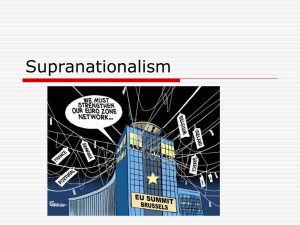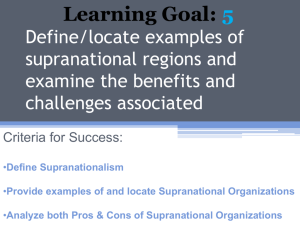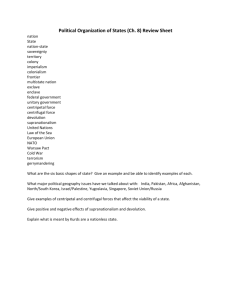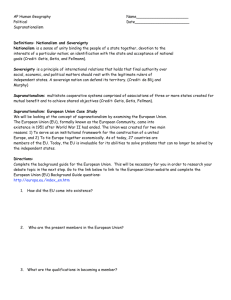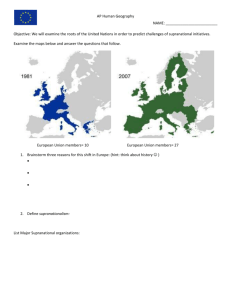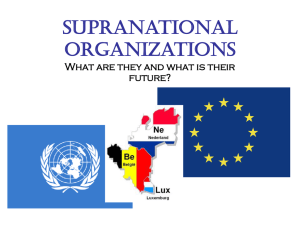supranationalism
advertisement
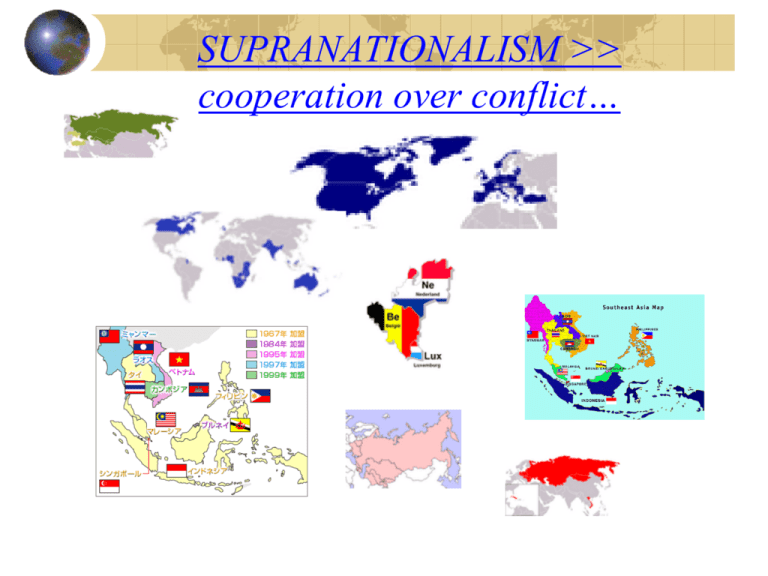
SUPRANATIONALISM >> cooperation over conflict… Supranationalism…. A supranational organization is one in which member states surrender power in specific areas to a higher organization. Decisions made by a supranational organization must be obeyed by the member states. Often there are courts to determine when violations have occurred, although frequently enforcement mechanisms are not as effective as they are within nation-states. Many supranat’l orgs are economic but can have political or military aspects such as EU, NATO… Examples of supranationalism European Union ASEAN – Association of SE Asian Nations… History of Supranational organizations Trade Leagues One of the most common forms of supranational organizations in history is that of leagues, generally composed of states seeking to resist some common military or economic threat by combining their forces. Early city leagues, such as the Achaean and Aetolian leagues in ancient Greece Remember also the Hanseatic and the Swabian leagues of Europe The Mandalas of South East Asia in the 1300’s – 1800’s NAFTA – first trade agreement b/t ‘MDC’ and ‘LDC’* countries… NAFTA decisions affect issues and create issues, such as where a highway route passes within a country… C o o p e r a t i o n +++++ -o -n -f -l -I -c -t Supranationalism –as more countries cooperate politically and economically, conflict is reduced on a local, regional and global scale. Spatial analysis of Supranationalism Usually found in w/in regions EU or NAFTA Some groups are more global UN, WTO, GATT, G8 The Future of Supranationalism ------- Issues------Supranational groups may ‘devolve’, fall apart like Yugoslavia The EU member states have failed to approve a constitution because of internal issues The Future of Supranationalism and globalism One day we ++++ Supranational groups Encourage Cooperation and trade thus Discouraging conflict/war could live on a truly global planet connected thru culture, politics, economics, etc… (like Coruscant!) THE EUROPEAN UNION and Supranationalism >Bringing Europe Together. 1957: The European Community or EC was created in western Europe. > Open to all democratic countries in Europe. > Eventually this group became the EEC and then the EU. ADVANTAGES of EU membership + No tariffs/import taxes on EU produced products going to EU countries No tariffs = lower prices = More sales = higher profits = Higher standard of living for all EU members + Common Passport + Common currency (17 of 26) + Universal voting --------------------------------------------= Everyone in the EU is happier! (circa 2007) ULTIMATE GOALS OF EU Political union > A ‘United States of Europe’ with a constitution, etc… - a constitution was voted down in Oct 05! Common currency Common military policy > Common eco policy/integration Membership requirements 1. Stable Democracy Human rights are protected Rule of Law is recognized Protection for minorities 2. Market economy in place Infrastructure functioning Stable eco 3. Agree to adopt common rules of EU Devolution issues One of the concerns (of member countries and potential members) is the loss of individual culture or identity. This is highlighted by EU rules for local foods and production that are designed to make Europe more homogeneous. Examples of this would be the Slovokian cucumbers or Hungarian “sausages”, and a specific definition for chocolate! DISADVANTAGES of membership 1. Increased economic competition between member nations 2. No protection for local industries (E Europe was used to this under communism…) 3. Possible unemployment in certain industries 4. Loss of ‘national’ identity Obstacles to complete unification History of hostilities (France vs. Germany, Germany vs. Russia, UK vs. France…..) Pride in own culture Nationalism – that nasty habit of being proud of your heritage. Costs of unification OBSTACLES TO EXPANSION for Eastern European nations Language issues different customs than W. Europe history of war amongst selves Strong national unity unstable governments low standard of living Poor infrastructure Not acquainted with a market economy b/c of 70 years of communism SIMILAR TRADE AGREEMENTS AROUND THE WORLD NAFTA: US/Canada/Mexico ASEAN: SE Asia OAS: Western Hemisphere FYI > Workers in the EU are paid high wages by world standards. They also receive generous benefits, high salaries and long vacations. They also receive socialized healthcare. > This limits the ability to make a profit and limits the number of new jobs created. > The EU is attempting to move lower income manufacturing jobs to the new Eastern European members in order to keep costs down. > The intent is to keep EU companies from relocating to China or Southeast Asia. The combined gross domestic product of the EU is roughly that of the USA. That makes the EU an economic competitor One goal of the EEC, the EC, and the European Union is to promote economic integration among member countries. This included the free flow or goods and services across the borders. Another goal of the EU is to make member countries more competitive in the global economy. They use a tax on economies to update infrastructure, industries, services and technologies in member countries. The major competitors to the EU are the USA, Japan, and China. 1993-A common currency was proposed. The Maastricht Treaty opened the way for the EURO, a currency used in 12 countries of the European Union. Three countries chose not to adopt the Euro. They were the Untied Kingdom (the “pound”, seen below), Sweden and Denmark. Countries such as the UK, France, Germany, are much wealthier than countries like Portugal, Spain, Greece. Another goal of the EU is to bring the lower tier countries up to the upper level of development. NGO’s -- Non-Government Organizations NAFTA OAS -- Organization of American States African Union
